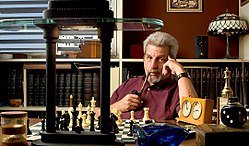Yakir Aharonov
| Yakir Aharonov | |
|---|---|
 |
|
| Born |
28 August 1932 Haifa, British Mandate of Palestine |
| Residence | United States |
| Nationality | Israeli |
| Fields | Physicist |
| Institutions |
Perimeter Institute Chapman University Tel Aviv University University of South Carolina George Mason University Brandeis University Yeshiva University |
| Alma mater |
Technion Bristol University |
| Doctoral advisor | David Bohm |
| Doctoral students |
Avi Marchewka David Albert Avshalom Elitzur Lev Vaidman Sandu Popescu |
| Known for |
Aharonov–Bohm effect Weak values Two-state vector formalism |
| Notable awards |
National Medal of Science (2009) Wolf Prize (1998) Elliott Cresson Medal (1991) |
| Notes | |
|
He is the uncle of Dorit Aharonov.
|
|
Yakir Aharonov (Hebrew: יקיר אהרונוב; born on August 28, 1932) is an Israeli physicist specializing in quantum physics. He is a Professor of Theoretical Physics and the James J. Farley Professor of Natural Philosophy at Chapman University in California. He is also a distinguished professor in the Perimeter Institute and a professor emeritus at Tel Aviv University in Israel. He is president of the IYAR, The Israeli Institute for Advanced Research.
Yakir Aharonov was born in Haifa. He received his undergraduate education at the Technion – Israel Institute of Technology in Haifa, graduating with a BSc in 1956. He continued his graduate studies at the Technion and then moved to Bristol University, UK together with his doctoral advisor David Bohm, receiving a PhD degree in 1960.
His research interests are nonlocal and topological effects in quantum mechanics, quantum field theories and interpretations of quantum mechanics. In 1959, he and David Bohm proposed the Aharonov–Bohm effect for which he co-received the 1998 Wolf Prize.
In 1988 Aharonov et al. published their theory of weak values. This work was motivated by Aharonov's long time quest to experimentally verify his theory that apparently random events in quantum mechanics are caused by events in the future (two-state vector formalism). Verifying a present effect of a future cause requires a measurement, which would ordinarily destroy coherence and ruin the experiment. He and his colleagues claim that they were able to use weak measurements and verify the present effect of the future cause.
...
Wikipedia
